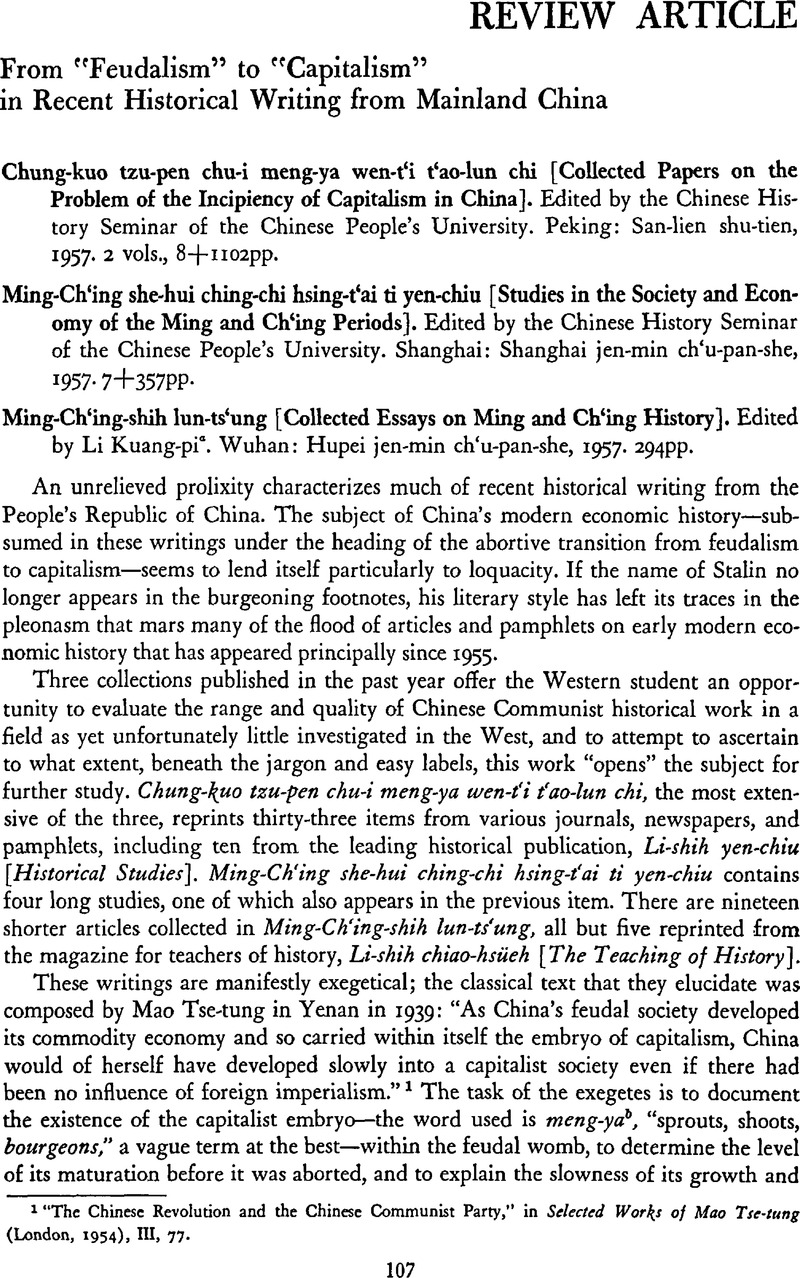Published online by Cambridge University Press: 23 March 2011

1 “The Chinese Revolution and the Chinese Communist Party,” in Selected Worlds of Mao Tse-tung (London, 1954), III, 77.Google Scholar
2 The transition from slavery to feudalism presents a similar problem to Chinese historians who are now writing at length on this subject as well. See Li-shih yen-chiu pien-chi-pu [The Editors of Historical Studies], compilers, Chung-kuo ti nu-li-chih yü feng-chien-chih fen-ch'i wen-ti lun-wen hsüan-chi [Collected Articles on the Problem of the Division Between the Period of Slavery and That of Feudalism in China](Peking, 1957).
3 Perhaps the concern with the feudalism-capitalism transformation is also a delayed reaction to the recent discussions among English-speaking and Japanese Marxists occasioned by Dobb's, MauriceStudies in the Development of Capitalism (London, 1947Google Scholar). See The Transition from Feudalism to Capitalism: a Symposium by Sweezy, Paul M. [and others](New York: Science and Society, 1954Google Scholar).
4 E. A. Kracke, Jr., “Sung Society: Change Within Tradition,” FEQ, XIV (August 1955), 479–488.
5 See Professor Naitō's posthumous work Chügoku kinsei shi [History of Modern China](Tokyo, 1947Google Scholar).
6 Schurmann, Herbert Franz, Economic Structure of the Yuan Dynasty (Cambridge, Mass., 1956)Google Scholar, vii, 4–5, 8–9, and passim.
7 See M. Postan, “Medieval Capitalism,” Economic History Review, ist Ser., IV (1932-34), 212-227.
8 H. R. Schubert, History of the British Iron and Steel Industry from c. 450 B.C. to A.D. 177$ (London, 1957), 244, 334, and Appendix IV, “Output Figures.”
9 Yen Chung-p'ing, Ch'ing-tai Yün-nan t'ung-cheng k'ao [A Study of the Copper Industry in Yunnan During the Ch'ing Dynasty](Peking, 1957).
10 See P'eng Tse-i, comp., Chung-kuo chin-tai shou-kung-yeh shih tzu-liao (1840-1949) [Source Materials on Handicraft Industry in Modern China (1S40-1949)](Peking, 1957), 4 vols.; and Li Wenchihm, comp., Chung fato chin-tai nung-yeh shih tzu-liao, 1840-1911 [Source Materials on Agriculture in Modern China, 1840—1911](Peking, 1957)—there are two additional volumes in this collection, complied by two other scholars and dealing respectively with the periods 1912—27 and 1927—37.
11 See Lien-sheng Yang, “Numbers and Units in Chinese Economic History,” HJAS, XII (June 1949), 216-225.